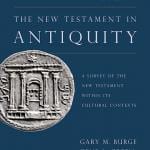This is a blog series featuring contributors to the new book, Cruciform Scripture. Today we have Dr. Sherri Brown. Cruciform Scripture is a book in the field of New Testament theology, the work is written in honor of the scholarship of Dr. Michael J. Gorman.
Dr. Sherri Brown (Creighton University)
Chapter Ten: “‘Follow Me’: The Mandate for Mission in the Gospel of John”

Tell us about your connection to the honoree, Michael Gorman.
I did not have the fortune to have Michael Gorman as a professor, but met him early in my career as a scholar and teacher through Christopher Skinner. Chris and I are “doctor-sibs” under the mentorship of Frank Moloney, and Chris had the great fortune of adjuncting at St. Mary’s as we concluded our doctorates. Chris introduced me to Mike at an SBL confererence, then I participated in a conference on John’s Gospel at St. Mary’s where Mike was the consummate host. In the meantime, I was using his textbook on Paul as the “Apostle of the Crucified Lord” in both my upper undergrad and lower grad courses on Paul and his Letters. Mike immediately included me into his community of peers. Our conversations at conferences from then on have been part of my maturing as a scholar. Indeed, while reviewing one of his books on Paul’s cruciform gospel of mission, I found his quote of 2 Peter 1:4 as a halmark of theosis in the New Testament. At the time I had been commissioned to contribute the entry on 2 Peter for the Paulist Biblical Commentary, and he quite inadvertantly gave me my way into the letter and its substance. When I later published an article on 2 Peter, he was one of the first to congratulate me. I, in turn, reminded him of his inspiration for my way in. He has been an enormously generous and kind colleague and I consider it my good fortune to count him a friend as well.
How did you choose your topic for the book, mission in John?
Beyond brief forays into the Catholic Epistles (as above) and Paul, the primary work of my career has been studying the Johannine Literature. When Chris Skinner told me that he and his fellow editors were endeavoring to produce what would be a surprise essay collection honoring Mike, I shared my enthusiasm for the project and, while acknowledging that I was neither a student nor a long-standing peer, I would love to express my respect for Mike if a contribution was needed. Some time later, Chris contacted me to say they could include something from me, especially if it was on John. Mike had recently published his foray into the Johannine world entitled, Abide and Go: Missional Theosis in the Gospel of John, which I loved, and I was about to embark upon a small volume on Johannine discipleship. I knew I could use this as an opportunity for double-duty: pay a bit of homage to Mike, his fantastic work, and his collegiality, as well as articulate my thoughts on Johannine discipleship in an article that would serve as a precis of sorts for the monograph.
Can you share more about your essay on John?
In recent years, scholars of the Johannine Literature have begun exploring the ethical implications of these texts with renewed interest, often challenging long-standing stereotypes of the absence of such mandates in favor of Christological and/or sectarian concerns. A corresponding extension of this developing interest lies in the study of Johannine spirituality. These interpreters have moved away from a focus on a spiritual interiority that is disconnected from concrete this-worldly existence to explore the Johannine approach to mission. In his important contribution to the discussion, Michael Gorman identifies such an approach as reading John through a “missional hermeneutic.” That is to say, transformative participation in the life of God through the incarnation of the divine into the earthly (by way of believing that Jesus is the Christ and Son of God and entering into the resulting relationship [1:10–14]) bestows a union of divine indwelling that, then, creates an outward-turning toward mission, inclusion, and active, justice-seeking discipleship.
The current essay builds upon this scholarly interest and tracks the narrative unfolding of John’s establishment of what it means to be children of God and the invitations and imperatives that ensue for all disciples that culminate in a mandate for mission in the new covenant. Through both narration and direct summons, characters in and audiences of the Gospel of John are beckoned to deeper relationship with God through Jesus as he challenges them to open themselves to what God is doing in their lives now. Indeed, Jesus’s first words of the Gospel, the query “what are you seeking?” set the tone for the invitation-as-imperative (or, imperative-as-invitation): “come and see,” made to both his first and all potential disciples (1:38–39).
The primary commandments presented across the narrative are to receive and believe Jesus as Christ and Son of God, which is manifested in abiding and loving one another in community (1:12; 13:34–35). Further, Jesus tasks inquisitors to know the truth so that it will set them free (8:31–32; 19:37–38). Some respond positively; others do not, but the hope for those who do is to have life in Jesus’s name (20:30–31). Jesus’s final challenge of the Gospel, then, is for those who believe and love to “follow me”—the underlying imperative of the entire Gospel (21:22), punctuated in the lives of real disciples who must live by Jesus’s command to believe without seeing. But this is not just a call to an interior spirituality; rather, it is a challenge to participate in the divine indwelling relationship by living the way Jesus lived: a life of concrete action through receiving, loving, and abiding with others in this world. This is the Gospel’s mandate for mission, and its purpose is to prepare audiences to do just that.
Brown has co-written a handbook to studying the Johannine Literature:
Interpreting the Gospel and Letters of John, Brown and Francis J. Moloney















